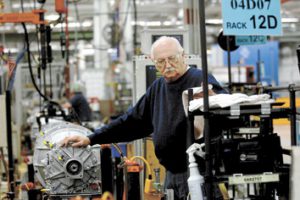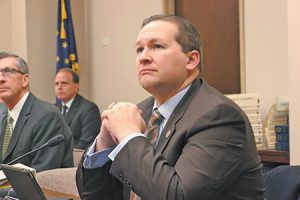
Indiana unemployment rate sinks to near-record low
Indiana's unemployment rate made a a big drop in May, falling to 3.2 percent, the state’s Department of Workforce Development said Friday.

Indiana's unemployment rate made a a big drop in May, falling to 3.2 percent, the state’s Department of Workforce Development said Friday.
U.S. employers added just 98,000 jobs in March, the fewest in a year, but the unemployment rate fell to a nearly 10-year low of 4.5 percent, down from 4.7 percent in February.
Indiana’s unemployment rate rose slightly in February, the state’s Department of Workforce Development said Friday, due to gains in the number of people seeking employment.
Indiana lost private-sector jobs for the second straight month, but private-sector employment has grown by more than 31,000 over the past year.

The Indiana Chamber of Commerce, organized labor groups and a bipartisan group of lawmakers have for years pushed the Legislature to implement a work-sharing program.
U.S. employers added a healthy 227,000 jobs last month and more Americans began looking for work—developments that President Donald Trump interpreted as confidence in his administration.
Private-sector employment in Indiana grew by almost 23,000 overall in 2016, but fell by 6,000 in December.
Private-sector employment in the state grew by 13,300 jobs during the month, the state said, and is up by 36,500 this year.
The state’s seasonally-adjusted unemployment rate dipped one-tenth of a percentage point in October as private-sector employment grew by 3,400 jobs, the Indiana Department of Workforce Development said Friday.
The state’s seasonally-adjusted unemployment rate fell to 4.5 percent in August as the number of employed people rose to an all-time high, the Indiana Department of Workforce Development said Tuesday.
The jobless rate dropped from 4.8 percent in June and 5 percent in May thanks to surging employment numbers, the Indiana Department of Workforce Development said Friday.
The labor force and the number of employed people both hit all-time highs in Indiana in June.
The unemployment rate rose in June from 4.7 percent to 4.9 percent. But the uptick occurred mainly for an encouraging reason: More Americans began seeking jobs.
Indiana’s unemployment rate jumped to 5.2 percent in April as another surge of jobless Hoosiers declared themselves ready to find work.
Indiana’s unemployment rate jumped to 5 percent in March as a surge of jobless Hoosiers declared themselves ready to find work.
The state’s unemployment rate rose to 4.7 percent in February, up from 4.6 percent the previous two months, the Indiana Department of Workforce Development announced Friday morning.
Indiana’s monthly unemployment rate was revised slightly upward in December, to 4.6 percent, and remained at that rate in January, the state announced Monday morning.
U.S. employers added a robust 242,000 workers in February as retailers, restaurants and health care providers drove another solid month for the resilient American job market.
While Americans of all stripes consistently put the economy at or near the top of their lists of most important issues, they may have very different concerns in mind when they do so.
Employers raised pay, more people felt confident enough to look for work, and the unemployment rate dipped to 4.9 percent, its lowest level since 2008.